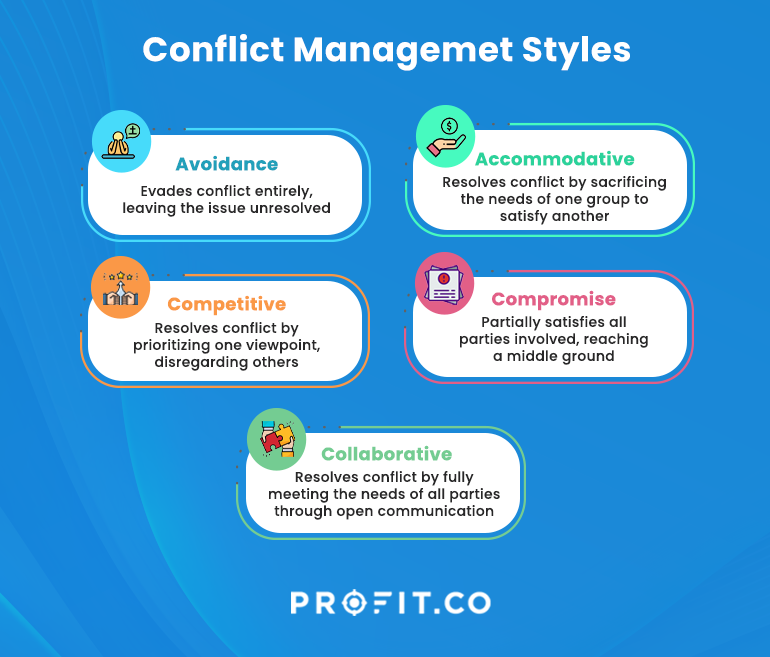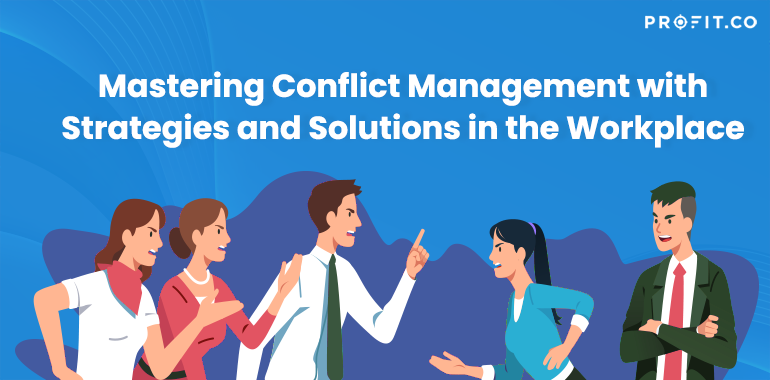Introduction
Conflict is the disagreement or difference of opinions between individuals that can potentially harm any organization. In the workplace setting, it often involves personal agendas, insights, or goals versus those of the group or team. Conflict management seeks to resolve these disagreements positively, with outcomes that satisfy everyone involved or benefit the group.
However, the perception of conflict is often negative.
The reality is that conflict can be positive if managed properly, promoting team-building skills, critical thinking, new ideas, and alternative solutions. Leaders must master conflict management to ensure team success.
In this blog, we’ll look into the essentials of conflict management, explore different styles and strategies, and provide practical tips and FAQs.
The Importance of Conflict Management
Conflict management is crucial in ensuring that team members work harmoniously towards common goals. Managed effectively, conflict can encourage learning and growth in an organization.
Benefits of Conflict Management
- Enhanced Team Cohesion: Teams can build stronger bonds and trust by resolving conflicts collaboratively.
- Increased Innovation: Differing viewpoints often lead to new ideas and creative solutions.
- Improved Communication: Conflict resolution fosters open dialogue and effective listening.
- Reduced Workplace Stress: Properly managed conflict minimizes tension, improving overall morale.
To learn how you can optimize your organization’s performance!
Conflict Management Styles
Conflict management styles reflect leadership styles and significantly impact how disagreements are resolved. Here are the five styles identified by Thomas and Kilmann:

Avoidance
In this style, individuals involved in the conflict simply avoid the situation or ignore its existence. This approach may be useful temporarily to de-escalate a tense situation. However, it’s a losing situation in the long run as unresolved conflict festers and creates more tension.
Accommodative
In this style, one party wins, and one party loses. The losing party easily gives in when the problem is not so important to them or when they want to keep the peace. The resolution benefits one side but can leave others feeling resentful and dissatisfied.
Competitive
In the competitive style, one party wins at the expense of the other. Although the conflict is resolved, this style can foster resentment and hinder teamwork.
Compromise
In compromise, each party sacrifices a portion of their solution, leading to a resolution that partially satisfies both sides. However, the best outcome might not always prevail, potentially leaving some parties feeling shortchanged.
Collaborative
The collaborative style aims to bring all parties together to find a resolution that benefits everyone involved. It incorporates active listening, respectful communication, and open-mindedness to reach the best possible solution.
“To get something new done you have to be stubborn and focused, to the point that others might find unreasonable.”
7 Steps in Conflict Management
1. Set Communication Rules
Establish ground rules for respectful communication before discussions begin. For cross-cultural conflicts, it’s important to consider cultural nuances in communication styles and norms.
2. Set Aside Preconceived Opinions
Ask all parties to approach the conflict with an open mind. In virtual team settings, be mindful of potential misunderstandings due to lack of non-verbal cues.
3. Active Listening
Encourage active listening without interruptions. Having emotional intelligence skills like empathy and self-awareness can greatly aid in truly understanding different perspectives during conflicts.
4. Define the Problem
Write down and restate the problem to ensure mutual understanding. Use collaboration tools or online platforms to document the issue for virtual teams.
5. Propose Solutions
Have each party suggest potential solutions. Online whiteboards or ideation tools can facilitate this process for remote teams.
6. Customer Lifetime Value (CLTV)
Evaluate the positive and negative aspects of each solution. Involve legal or HR departments if the conflict has potential legal or policy implications.
7. Agree on a Resolution
Choose a solution that benefits everyone involved or is beneficial to the group. Establish metrics like employee satisfaction, productivity or turnover rates to measure the effectiveness of the resolution.
Proactive conflict prevention strategies, such as clear communication, setting expectations, and building trust, can also help avoid conflicts from arising or escalating.
Conflict Management in Organizations
- Party-Directed Mediation (PDM): Suitable for disputes between co-workers, it involves pre-mediation coaching and role-playing before a joint session.
- Negotiated Performance Appraisal (NPA): Improves communication between supervisors and subordinates, preserving hierarchical power while encouraging dialogue.
- International Conflict Management: When managing conflicts across cultures, it’s essential to understand cultural differences in communication, traditions, and thought processes. A Confrontational style may not work well in cultures where harmony is prioritized.
- Inter-Organizational Conflict Management: In inter-organizational relationships, conflicts involve both individuals and organizations. Formal and informal governance mechanisms influence the type of conflicts and how they’re managed.
Conflict Resolution Case Study
Google vs. Antitrust Regulators
In response to antitrust charges, Google followed its principle “Don’t litigate, negotiate.” By engaging in direct negotiations with regulators, Google adapted its practices and provided settlements to affected parties, avoiding litigation and improving relations.
Apple vs. Samsung
Apple and Samsung ended their long-running patent dispute with a settlement, concluding a seven-year legal battle over whether Samsung copied the iPhone. While settlement terms remain undisclosed, Apple emphasized the case was always about protecting innovation beyond monetary compensation. The settlement between Apple and Samsung shows how compromise and collaboration can help resolve long-standing disputes while protecting core business interests.
Frequently Asked Questions (FAQs)
Q1: What are the five styles of conflict management?
A1: The five styles of conflict management are Avoidance, Accommodative, Competitive, Compromise, and Collaborative.
Q2: How can conflict management benefit an organization?
A2: Conflict management can enhance team cohesion, improve communication, foster innovation, and reduce workplace stress.
Q3: What is Party-Directed Mediation (PDM)?
A3: PDM is a mediation approach suitable for disputes between colleagues. It involves coaching and role-playing before a joint mediation session.
Q4: How can leaders effectively manage international conflicts?
A4: Leaders should understand cultural differences in communication, traditions, and thought processes to navigate international conflicts.
Q5: What are the key steps to resolving workplace conflicts?
A5: The key steps include setting communication rules, actively listening, defining the problem, proposing solutions, discussing pros and cons, and agreeing on a resolution.
Conclusion
Conflict management is the process of limiting the negative aspects of conflict while increasing the positive aspects to enhance learning and group outcomes. Properly managed conflict can improve organizational performance and foster innovation, communication, and team cohesion. Leaders must be well-versed in conflict management styles and strategies to create a harmonious and productive workplace.
To learn more about Profit.co and deploy it within your organization
Related Articles
-
How Resource Leveling Can Keep Your Projects from Crashing and Burning
In project management, trying to do it all at once is a fast track to chaos—missed deadlines, stressed-out teams, and... Read more
-
Turning Knowledge Into Action for Project Portfolio Success
Managing a bunch of projects at once can feel like juggling flaming swords. It’s exciting. It's chaotic. And sometimes, it... Read more
-
How to Create an Effective Proof of Concept (POC): Best Practices & Examples
You have an idea, and it’s really a good one. You tell your roommate and friends, but they don’t believe... Read more
-
Construction Project Management: Best Practices and Tips for Success
Project management in construction is a responsibility. It requires precision, leadership, and the ability to overcome complexities that come with... Read more

